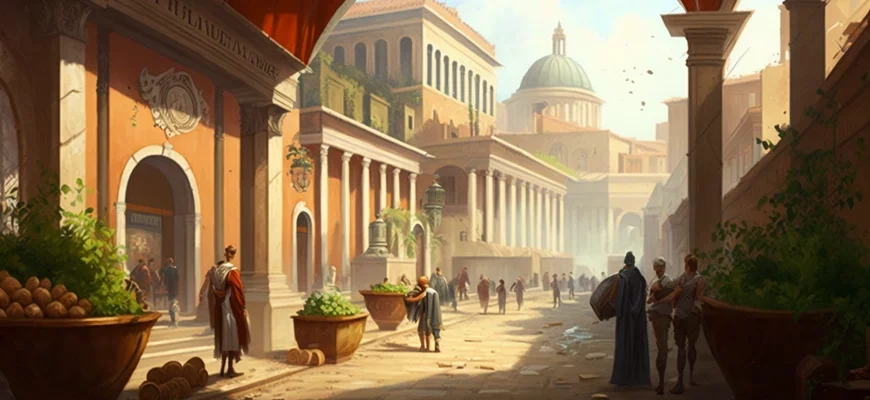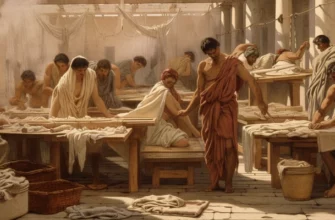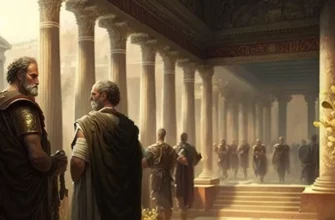The economy of ancient Rome was based on its large territory, rich resources, and military power. The Roman economy was based on agriculture, trade, and crafts, as well as financial institutions such as the monetary system and the banking system.
The Roman monetary system was one of the first in the world and was based on gold and silver. The banking system included institutions that provided loans and stored funds.
Trade and the market economy were important sectors of the Roman economy. Markets were places where goods were traded, which were delivered to the city from other regions by road and sea.
The state had a significant influence on the Roman economy. The tax system was complex and included various types of taxes. Government procurement and price regulation also played an important role in the development of Rome’s economy.
All these factors helped to create one of the largest and richest economies in the world at that time, which became the basis for the further development of the culture and science of the Roman Empire.
The development of money and the financial system
The development of money and the financial system of ancient Rome was very important for the development of the empire’s economy. Rome used gold and silver coins, which were accepted throughout the empire.
Rome’s monetary system was highly developed and included coins of various values and sizes, including the denarius, sestertius, aureus, and others. Each coin had a corresponding value, which allowed for economic transactions and trade.
The banking system of Rome was also highly developed. Banks provided loans and stored money. Bankers also issued paper tickets that could be exchanged for money.
The financial system of Rome included various types of transactions, such as investments in construction and development projects, government debt, and others. This allowed the Roman economy to develop and strengthen, which was important for the further development of the empire.
Monetary system
The monetary system of ancient Rome was highly developed and had a great influence on the development of the empire’s economy. The system included coins of various values and sizes, such as the denarius, sestertius, aureus, and others. Each coin had a corresponding value, which allowed for economic transactions and trade. The Roman monetary system also included savings devices, such as chests, which were convenient for storing coins and valuables.
Banking system
The banking system of ancient Rome was highly developed and included various types of banks and financial institutions. Banks provided loans and stored money, while bankers issued paper tickets that could be exchanged for money. Bankers also carried out currency exchange and money transfer operations, which enabled trade and business transactions in different parts of the empire. Banks also provided financial support for construction and development projects, which contributed to the development of the empire’s economy.
Trade and market economy
Trade and the market economy of ancient Rome were highly developed and included various types of markets, such as daily markets, fairs, and trading places. The Romans traded various goods, such as food, textiles, metals, glassware, and others. Trade took place not only within the empire, but also with other countries, which contributed to the development of international trade. The market economy included competition between sellers and a developed system of prices regulated by supply and demand. Trade transactions were carried out using money and credit operations, which contributed to the economic development of the empire.
Organization of trade and the market
The organization of trade and the market in ancient Rome was quite complex and ramified. Trade transactions were carried out at daily markets, which took place on the streets of cities, as well as at annual fairs and trading places located near important transport routes. The Romans also used sea routes to trade with other countries. The organization of the market included various rules and laws that regulated the activities of sellers and buyers. For example, quality standards were established for food products, and rules regarding tariffs and taxes were introduced. The Romans also used a monetary system for conducting trade transactions and were familiar with various types of credit transactions, such as loans and storing money in banks.
Development of transport and logistics
The development of transport and logistics was an important aspect of the economic development of ancient Rome. The roads and bridges built by the Romans ensured the fast and safe transport of goods and people. The Roman Empire also used water transport to move cargo and passengers along rivers and seas. To ensure the safety and efficiency of transport, a logistics system was created that included warehousing, delivery of goods to markets, and organization of food storage. In addition, the Romans created special guilds of merchants and carriers who controlled the quality of goods and ensured their safe delivery to their destinations. All these measures contributed to the development of trade and the economy as a whole.
The role of the state in the economy
The state played an important role in ensuring the stability and development of the economy in ancient Rome. It set taxes and regulated production, providing the necessary resources and controlling prices for goods. In addition, the state promoted trade and maintained relations with other countries, which contributed to the development of international trade. The state also ensured the protection of trade routes and exercised control over weights and measures. Overall, state policy stimulated economic development and ensured stability in society.
Tax system
The tax system of ancient Rome was quite complex and diverse. The state collected taxes from various sources: land tax, trade and production taxes, inheritance taxes, land contributions, and others. Taxes were collected both in cash and in kind. The amount of taxes depended on the taxpayer’s social status, property status, and occupation. Taxpayers could be individuals, businesses, or organizations. In addition, the state controlled the use of the collected funds and ensured that they were properly directed to the needs of the state. In general, the tax system helped the state secure the necessary resources for economic development and meeting the needs of the population.
Public procurement and price regulation
In ancient Rome, public procurement played an important role in meeting the needs of the state and the population. The state ensured the procurement of food, weapons, clothing, and other goods necessary for the functioning of the state and its army. Price regulation was also an important element of the state’s economic policy. The state set maximum and minimum prices for various goods and services, which ensured price stability and prevented abuse by traders and sellers. However, price regulation also had a negative impact on the development of entrepreneurship and trade, as it reduced incentives to develop new products and improve the quality of services.
Conclusion
The economy of ancient Rome was quite complex and developed. Rome had a developed monetary and banking system, trade and market economy, as well as an efficient transport and logistics system. Economic development was facilitated by the state, which provided public procurement and price regulation. However, the economy of ancient Rome also had certain problems, in particular, dependence on slavery and the uneven distribution of wealth, which could be a challenge to the stability of the economy and society as a whole. Overall, the economy of ancient Rome was an important prerequisite for the further development of the European economy.








